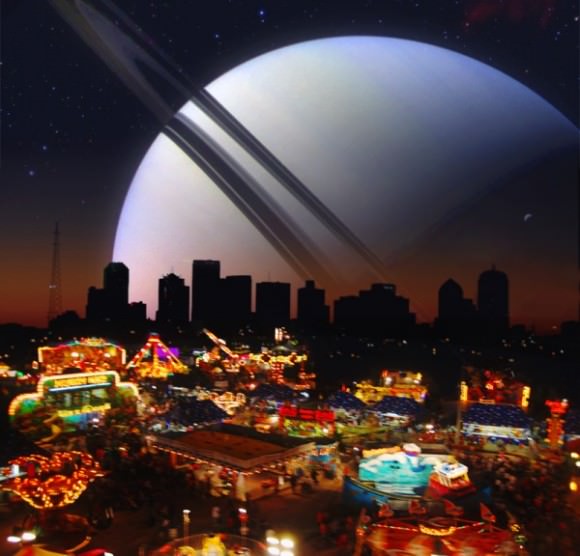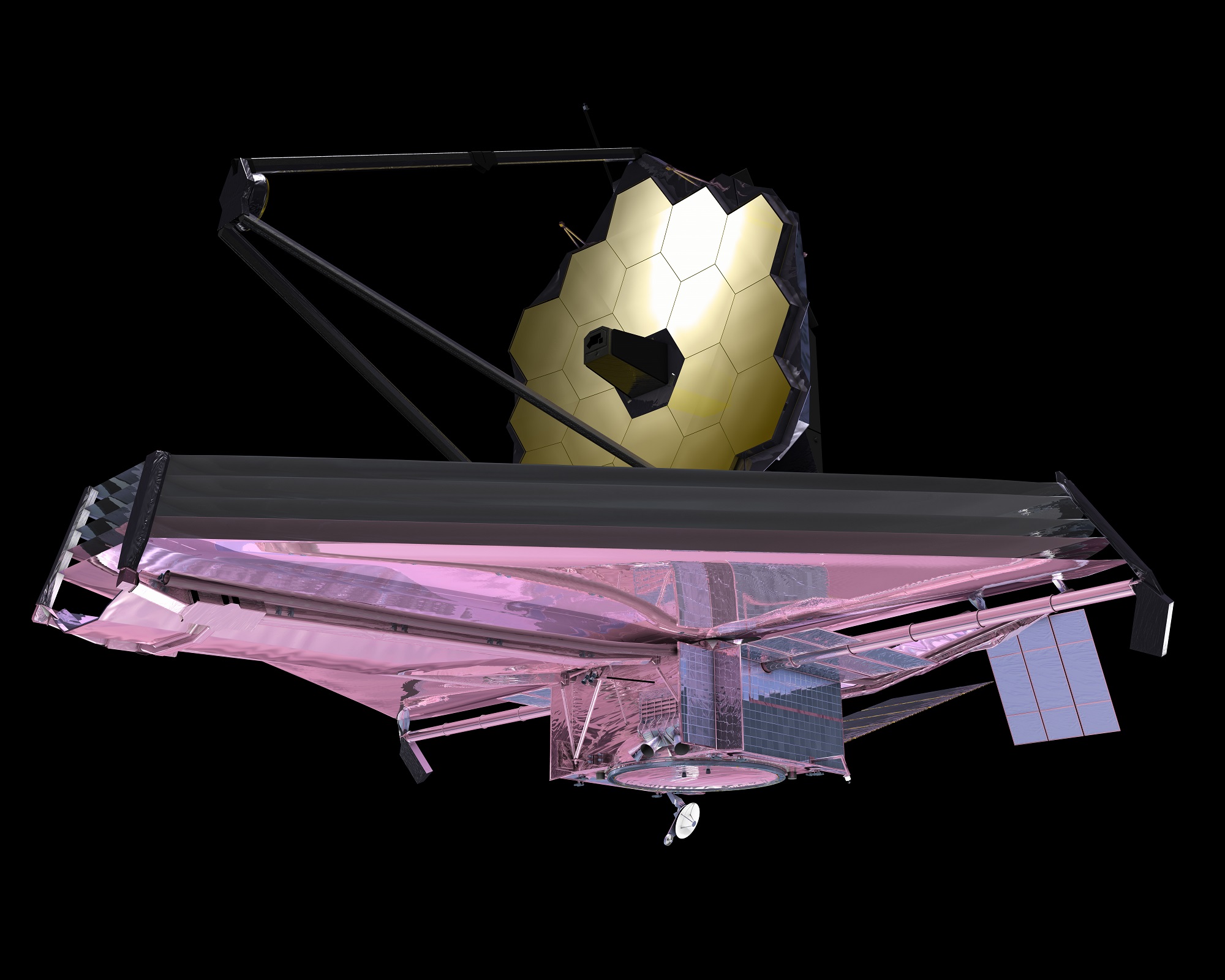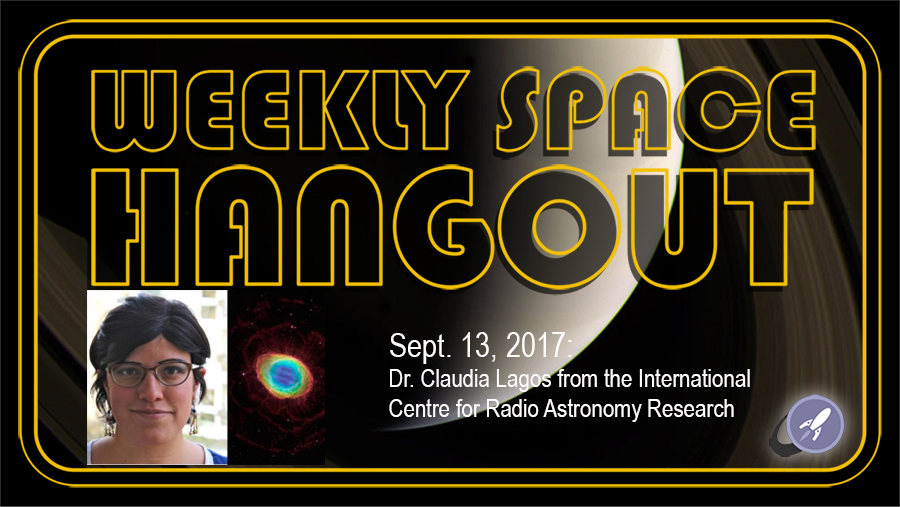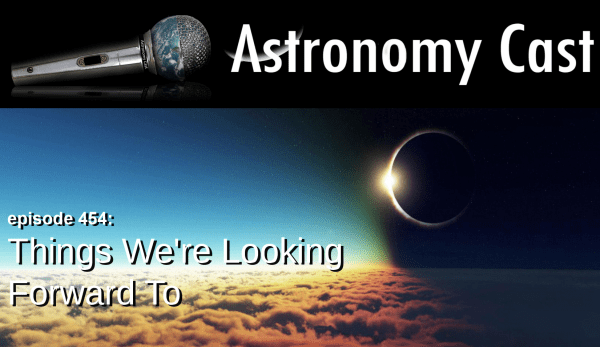Welcome to the 558th Carnival of Space! The Carnival is a community of space science and astronomy writers and bloggers, who submit their best work each week for your benefit. We have a fantastic roundup today, so now, on to this week’s stories!
Continue reading “Carnival of Space #558”
James Webb Wraps up 3 Months in the Freezer. It’s Ready for Space
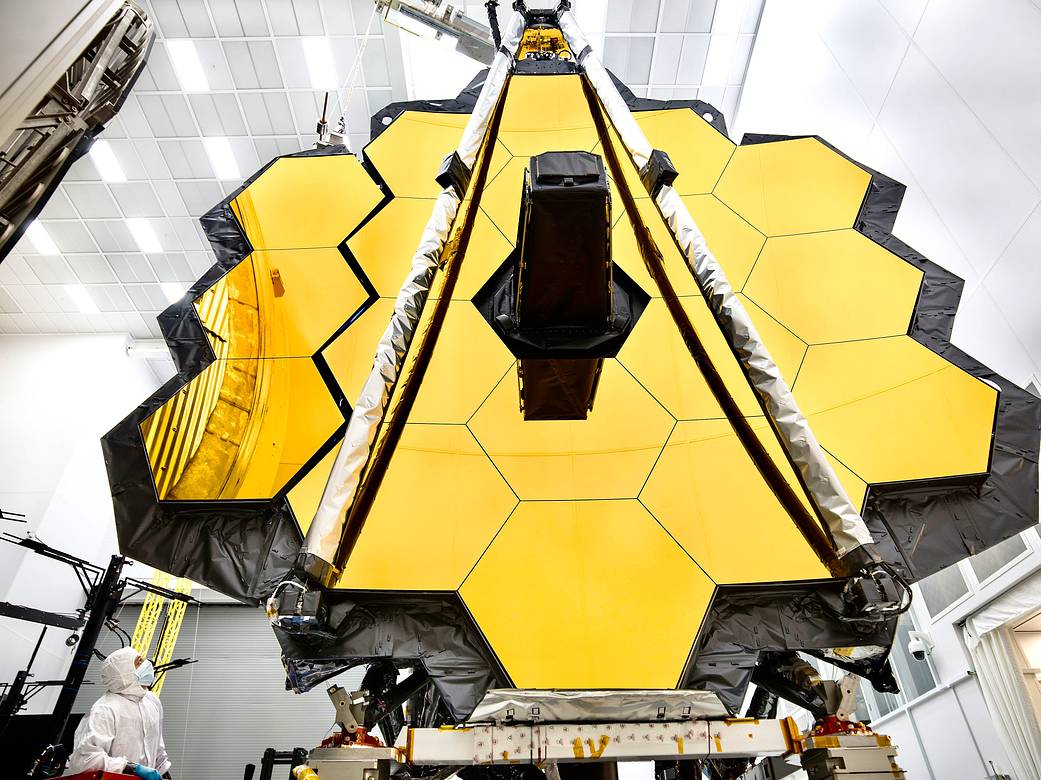
When the James Webb Space Telescope finally takes to space, it will study some of the most distant objects in the Universe, effectively looking back in time to see the earliest light of the cosmos. It will also study extra-solar planets around nearby stars and even bodies within the Solar System. In this respect, the JWST is the natural successor to Hubble and other pioneering space telescopes.
It is therefore understandable why the world is so eager for the JWST to be launched into space (which is now scheduled to take place in 2019). And recently, the telescope passed another major milestone along the road towards deployment. After spending three months in a chamber designed to simulate the temperatures and vacuum conditions of space, the JWST emerged and was given a clean bill of health.
The tests took place inside Chamber A, a thermal vacuum testing facility located at the Johnson Space Center in Houston, Texas. This chamber was built back in 1965 as part of NASA’s race to the Moon, where it conducted tests to ensure that the Apollo command and service modules were space-worthy. Beginning in mid-July, the telescope was put into the chamber and subjected to temperatures ranging from 20 to 40 K (-253 to -233 °C; 423 to 387 °F).
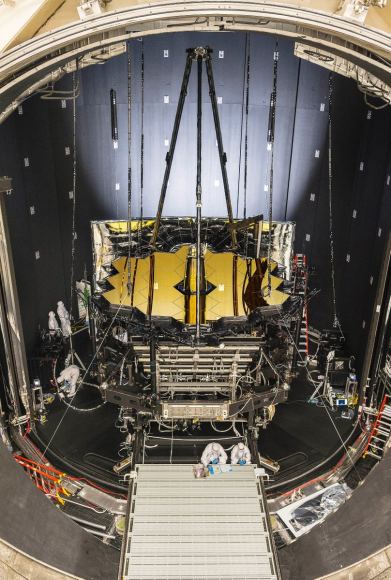
Once the temperature and vacuum conditions were just right, a team of NASA engineers began testing the alignment of the JWST’s 18 primary mirror segments to make sure they would act as a single, 6.5-meter telescope. As Bill Ochs – the James Webb telescope project manager at NASA’s Goddard Space Flight Center – indicated to ArsTechnica, this latest test has shown that the telescope is indeed space-worthy.
“We now have verified that NASA and its partners have an outstanding telescope and set of science instruments,” he said. “We are marching toward launch.”
The team of engineers also tested the JWST’s guidance and optical systems by simulating the light of a distant star. Not only was the telescope able to detect the light, its optical systems were able to process it. The telescope was also able to track the simulated star’s movement, which demonstrated that the JWST will be able to acquire and hold research targets once it is in space.
Many tests are still needed before the JWST can take to space next year. These will be conducted at Northrop Grumman’s company headquarters in Los Angeles, where the telescope will be transported after leaving the Johnson Space Center in late January or early February. Once there, the optical instrument will mated to the spacecraft and sunshield to complete the construction of the telescope.
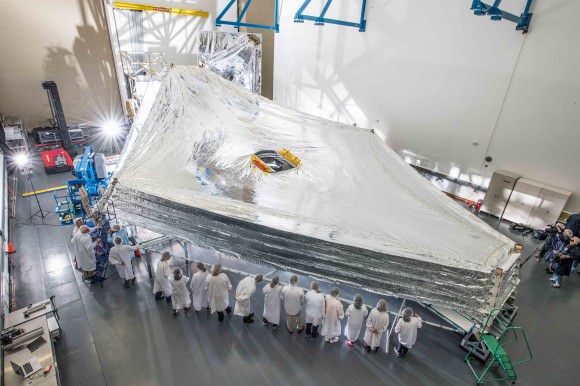
These tests are necessary since NASA will be hard-pressed to service the telescope once it is in space. This is due to the fact that it will be operating at the Earth-Sun L2 Lagrange Point (which will place farther away from Earth than the Moon) for a minimum of five years. At this distance, any servicing missions will be incredibly difficult, time-consuming and expensive to mount.
However, once the JWST has passed its entire battery of tests and NASA is satisfied it is ready to take to space, it will be shipped off to the Guiana Space Center in Kourou, French Guiana. Once there, it will launch aboard a European Space Agency (ESA) Ariane V booster. Originally, this was scheduled to take place in October of 2017, but is now expected to take place no earlier than Spring of 2018.
When the James Webb Space Telescope is operational, it is expected to reveal some truly amazing things about our Universe. In addition to looking farther into space than any previous telescope (and further back in time), its other research goals include studying nearby exoplanets in unprecedented detail, circumstellar debris disks, supermassive black holes at the centers of galaxies, and even searching for life in the Solar System by examining Jupiter’s moons.
For this reason, NASA can be forgiven for pushing the launch back to make sure everything is in working order. But of course, we can be forgiven for wanting to see it launched as soon as possible! There are mysteries out there that are just waiting to be revealed, and some amazing scientific finds that need to be followed up on.
In the meantime, be sure to check out this video about the JWST, courtesy of NASA:
Further Reading: ArsTechnica, NASA
Weekly Space Hangout – Jan 3, 2018: Dr. Jeyhan Kartaltepe of the Cosmic Evolution Early Release Science (CEERS) Survey
Hosts:
Fraser Cain (universetoday.com / @fcain)
Dr. Paul M. Sutter (pmsutter.com / @PaulMattSutter)
Dr. Kimberly Cartier (KimberlyCartier.org / @AstroKimCartier )
Dr. Morgan Rehnberg (MorganRehnberg.com / @MorganRehnberg & ChartYourWorld.org)
Special Guest:
Dr. Jeyhan Kartaltepe is an Assistant Professor of Physics at Rochester Institute of Technology, and is the Deputy Director of the Laboratory for Multiwavelength Astrophysics. She is also a leading member of the Cosmic Evolution Early Release Science (CEERS) Survey team that has been selected as part of the James Webb Space Telescope Director’s Discretionary Early Release Science Program. It is one of 13 science teams that will use the $8 billion telescope first, conducting experiments during its initial cycle and testing the instruments’ capabilities.
Announcements:
If you would like to join the Weekly Space Hangout Crew, visit their site here and sign up. They’re a great team who can help you join our online discussions!
We record the Weekly Space Hangout every Wednesday at 5:00 pm Pacific / 8:00 pm Eastern. You can watch us live on Universe Today, or the Weekly Space Hangout YouTube page – Please subscribe!
When James Webb Finally Reaches Space, Here’s What it’ll be Hunting
Ever since the project was first conceived, scientists have been eagerly awaiting the day that the James Webb Space Telescope (JWST) will take to space. As the planned successor to Hubble, the JWST will use its powerful infrared imaging capabilities to study some of the most distant objects in the Universe (such as the formation of the first galaxies) and study extra-solar planets around nearby stars.
However, there has been a lot of speculation and talk about which targets will be the JWST’s first. Thankfully, following the recommendation of the Time Allocation Committee and a thorough technical review, the Space Telescope Science Institute (STScI) recently announced that it has selected thirteen science “early release” programs, which the JWST will spend its first five months in service studying.
As part of the JWST Director’s Discretionary Early Release Science Program (DD-ERS), these thirteen targets were chosen by a rigorous peer-review process. This consisted of 253 investigators from 18 counties and 106 scientific institutions choosing from over 100 proposals. Each program has been allocated 500 hours of observing time, once the 6-month commissioning period has ended.
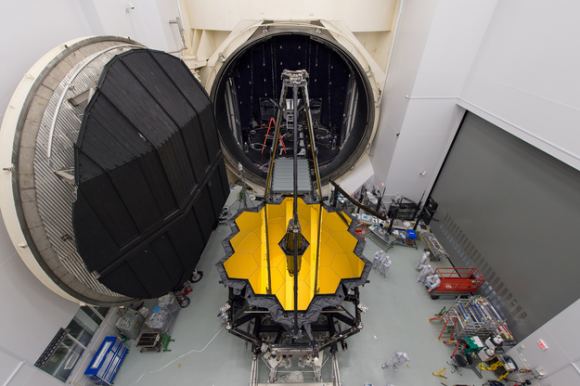
As Ken Sembach, the director of the Space Telescope Science Institute (STScI), said in an ESA press statement:
“We were impressed by the high quality of the proposals received. These programmes will not only generate great science, but will also be a unique resource for demonstrating the investigative capabilities of this extraordinary observatory to the worldwide scientific community… We want the research community to be as scientifically productive as possible, as early as possible, which is why I am so pleased to be able to dedicate nearly 500 hours of director’s discretionary time to these early release science observations.”
Each program will rely on the JWST’s suite of four scientific instruments, which have been contributed by NASA, the European Space Agency (ESA) and the Canadian Space Agency (CSA). These include the the Near-Infrared Spectrograph (NIRSpec) and the Mid-Infrared Instrument (MIRI) developed by the ESA, as well as the Near-Infrared Camera (NIRCam) developed by NASA and the STScI, and the Near-Infrared Imager and Slitless Spectrograph (NIRISS) developed by the CSA.
The thirteen programs selected include “Through the looking GLASS“, which will rely on the astronomical community’s experience using Hubble to conduct slitless spectroscopy and previous surveys to gather data on galaxy formation and the intergalactic medium, from the earliest epochs of the Universe to the present day. The Principal Investigator (PI) for this program is Tommaso Treu of the University of California Los Angeles.
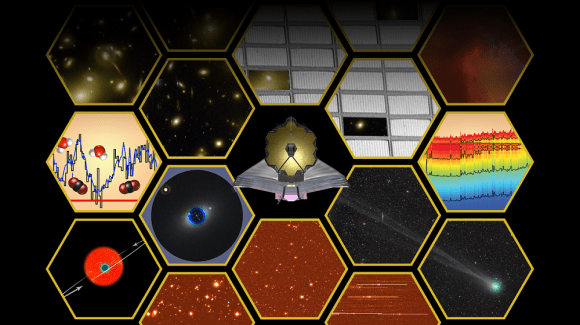
Another is the Cosmic Evolution Early Release Science (CEERS) program, which will conduct overlapping observations to create a coordinated extragalactic survey. This survey is intended to let astronomers see the first visible light of the Universe (ca. 240,000 to 300,000 years after the Big Bang), as well as information from the Reionization Epoch (ca. 150 million to 1 billion years after the Big Bang) and the period when the first galaxies formed. The PI for this program is Steven Finkelstein of the University of Texas at Austin.
Then there’s the Transiting Exoplanet Community Early Release Science Program, which will build on the work of the Hubble, Spitzer, and Kepler space telescopes by conducting exoplanet surveys. Like its predecessors, this will consist of monitoring stars for periodic dips in brightness that are caused by planets passing between them and the observer (aka. Transit Photometry).
However, compared to earlier missions, the JWST will be able to study transiting planets in unprecedented detail, which is anticipated to reveal volumes about their respective atmospheric compositions, structures and dynamics. This program, for which the PI is Imke de Pater from the University of California Berkeley, is therefore expected to revolutionize our understanding of planets, planet formation, and the origins of life.
Also focused on the study of exoplanets is the High Contrast Imaging of Exoplanets and Extraplanetary Systems program, which will focus on directly imaged planets and circumstellar debris disks. Once again, the goal is to use the JWST’s enhanced capabilities to provide detailed analyses on the atmospheric structure and compositions of exoplanets, as well as the cloud particle properties of debris disks.
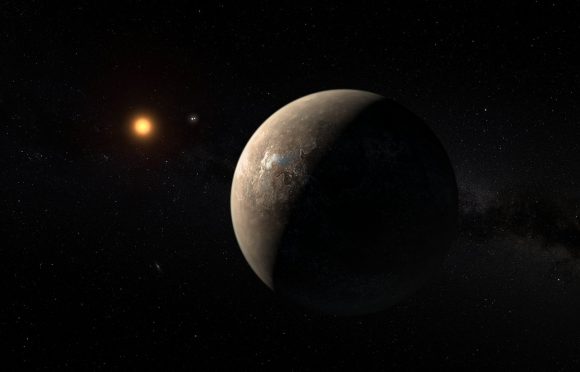
But of course, not all the programs are dedicated to the study of things beyond our Solar System, as is demonstrated by the program that will focus on Jupiter and the Jovian System. Adding to the research performed by the Galileo and Juno missions, the JWST will use its suite of instruments to characterize and produce maps of Jupiter’s cloud layers, winds, composition, auroral activity, and temperature structure.
This program will also focus on some of Jupiter’s largest moons (aka. the “Galilean Moons”) and the planet’s ring structure. Data obtained by the JWST will be used to produce maps of Io’s atmosphere and volcanic surface, Ganymede’s tenuous atmosphere, provide constrains on these moons thermal and atmospheric structure, and search for plumes on their surfaces. As Alvaro Giménez, the ESA Director of Science, proclaimed:
“It is exciting to see the engagement of the astronomical community in designing and proposing what will be the first scientific programs for the James Webb Space Telescope. Webb will revolutionize our understanding of the Universe and the results that will come out from these early observations will mark the beginning of a thrilling new adventure in astronomy.”
During its mission, which will last for a minimum of five years (barring extensions), the JWST will also address many other key topics in modern astronomy, probing the Universe beyond the limits of what Hubble has been capable of seeing. It will also build on observations made by Hubble, examining galaxies whose light has been stretched into infrared wavelengths by the expansion of space.
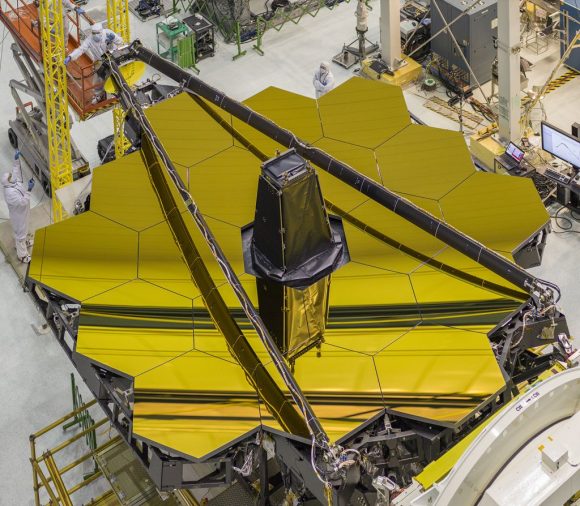
Beyond looking farther back in time to chart cosmic evolution, Webb will also examine the Supermassive Black Holes (SMBH) that lie at the centers of most massive galaxies – for the purpose of obtaining accurate mass estimates. Last, but not least, Webbwill focus on the birth of new stars and their planets, initially focusing on Jupiter-sized worlds and then shifting focus to study smaller super-Earths.
John C. Mather, the Senior Project Scientist for the JWST and a Senior Astrophysicist at NASA’s Goddard Space Flight Center, also expressed enthusiasm for the selected programs. “I’m thrilled to see the list of astronomers’ most fascinating targets for the Webb telescope, and extremely eager to see the results,” he said. “We fully expect to be surprised by what we find.”
For years, astronomers and researchers have been eagerly awaiting the day when the JWST begins gathering and releasing its first observations. With so many possibilities and so much waiting to be discovered, the telescope’s deployment (which is scheduled for 2019) is an event that can’t come soon enough!
NASA’s Webb Space Telescope Launch Delayed to 2019
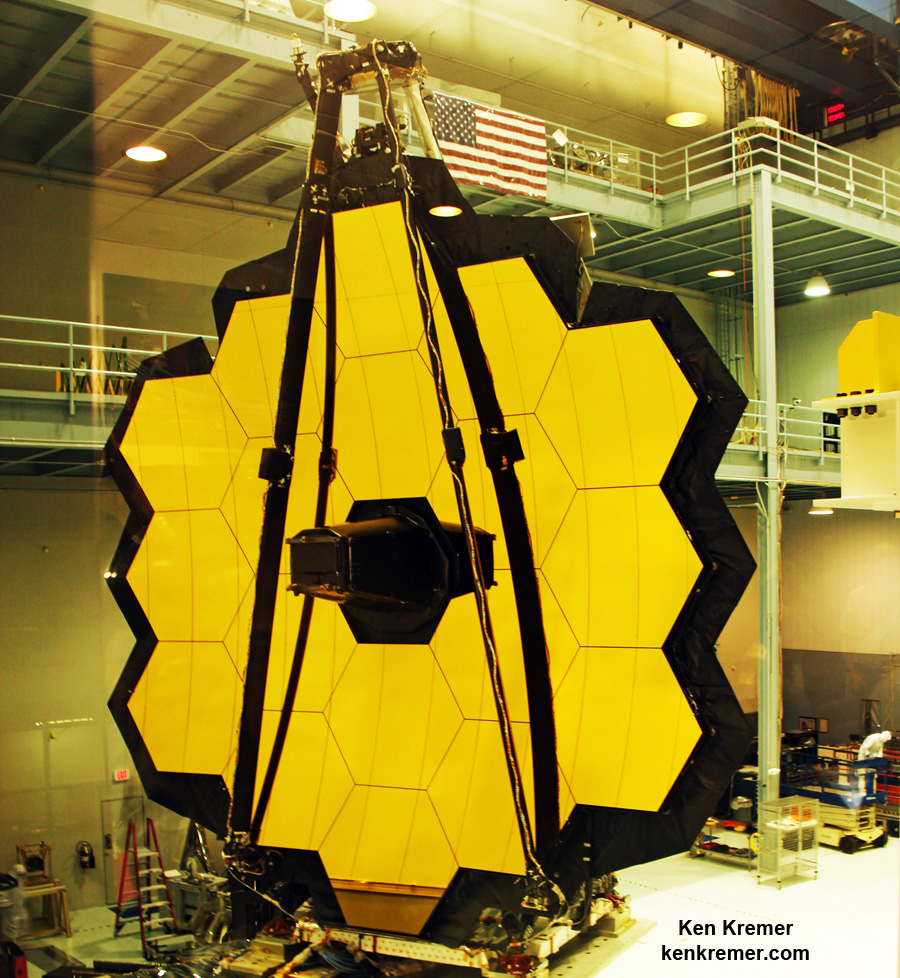

The most powerful space telescope ever built will have to wait on the ground for a few more months into 2019 before launching to the High Frontier and looking back nearly to the beginning of time and unraveling untold astronomical secrets on how the early Universe evolved – Engineers need a bit more time to complete the Webb telescopes incredibly complex assembly and testing here on Earth.
Blastoff of NASA’s mammoth James Webb Space Telescope (JWST) has been postponed from late 2018 to the spring of 2019.
“NASA’s James Webb Space Telescope now is planning to launch between March and June 2019 from French Guiana, following a schedule assessment of the remaining integration and test activities,” the agency announced.
Until now the Webb telescope was scheduled to launch on a European Space Agency (ESA) Ariane V booster from the Guiana Space Center in Kourou, French Guiana in October 2018.
“The change in launch timing is not indicative of hardware or technical performance concerns,” said Thomas Zurbuchen, associate administrator for NASA’s Science Mission Directorate at Headquarters in Washington, in a statement.
“Rather, the integration of the various spacecraft elements is taking longer than expected.”
NASA’s says the currently approved budget will not bust the budget or reduce the science output. It “accommodates the change in launch date, and the change will not affect planned science observations.”
NASA’s $8.8 Billion James Webb Space Telescope is the most powerful space telescope ever built and is the scientific successor to the phenomenally successful Hubble Space Telescope (HST).
The Webb Telescope is a joint international collaborative project between NASA, the European Space Agency (ESA) and the Canadian Space Agency (CSA).
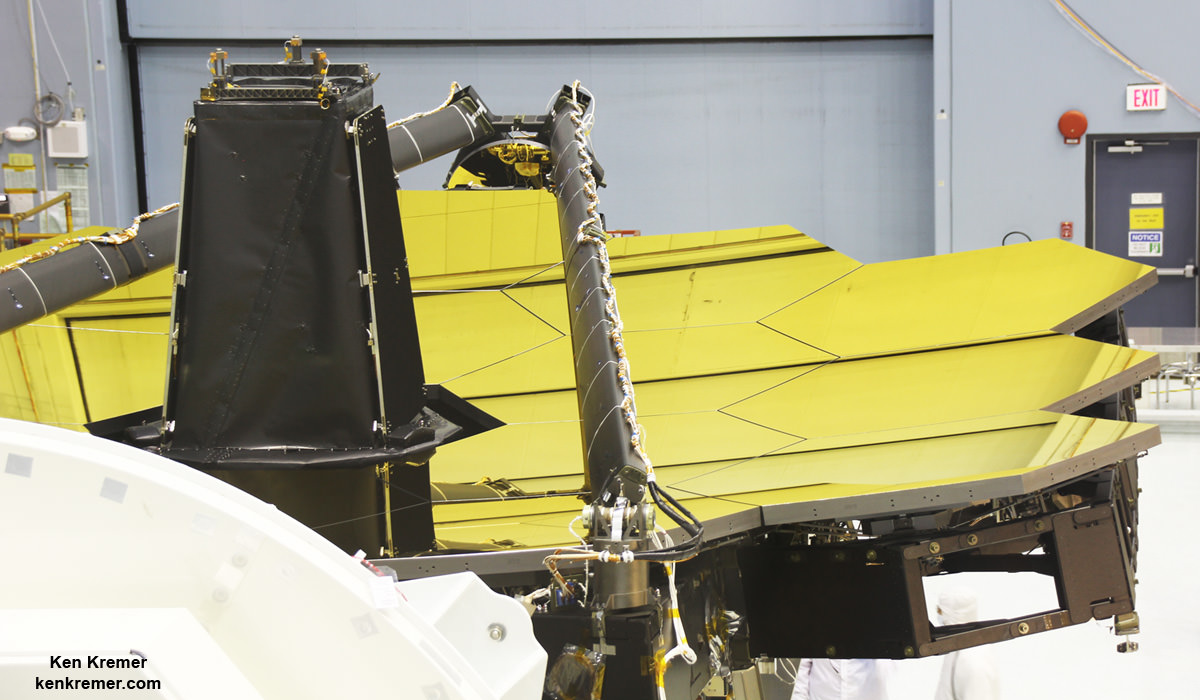
Since Webb is not designed to be serviced by astronauts, the extremely thorny telescope deployment process is designed to occur on its own over a period of several months and must be fully successful. Webb will be positioned at the L2 Lagrange point- a gravitationally stable spot approximately 930,000 miles (1.5 million km) away from Earth.
So its better to be safe than sorry and take the extra time needed to insure success of the hugely expensive project.

Various completed components of the Webb telescope are undergoing final testing around the country to confirm their suitability for launch.
Critical cryogenic cooling testing of Webb’s mirrors and science instrument bus is proceeding well inside a giant chamber at NASA’s Johnson Space Center in Texas.
However integration and testing of the complex multilayered sunshield at Northrup Grumman’s Redondo Beach, Ca. facility is taking longer than expected and “has experienced delays.”
The tennis court sized sunshield will protect the delicate optics and state of the art infrared science instruments on NASA’s Webb Telescope.
Webb’s four research instruments cannot function without the essential cooling provided by the sunshield deployment to maintain them at an operating temperature of minus 388 degrees F (minus 233 degrees C).
The Webb telescopes groundbreaking sunshield subsystem consists of five layers of kapton that will keep the optics and instruments incredibly cool, by reducing the incoming sunside facing temperature more than 570 degrees Fahrenheit. Each layer is as thin as a human hair.
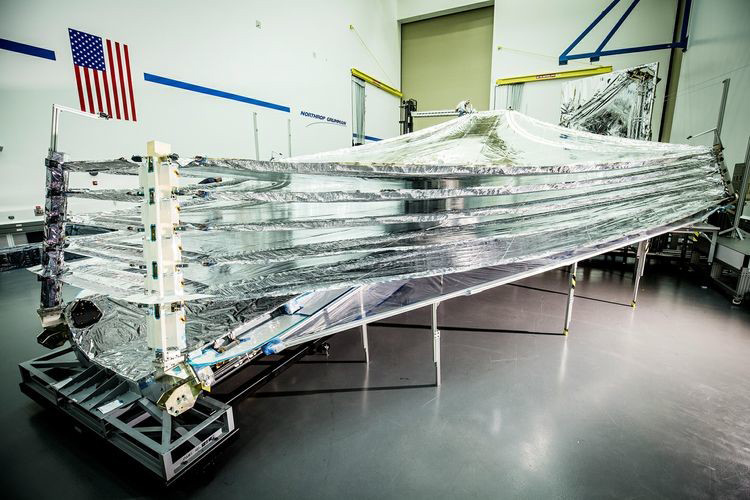
“Webb’s spacecraft and sunshield are larger and more complex than most spacecraft. The combination of some integration activities taking longer than initially planned, such as the installation of more than 100 sunshield membrane release devices, factoring in lessons learned from earlier testing, like longer time spans for vibration testing, has meant the integration and testing process is just taking longer,” said Eric Smith, program director for the James Webb Space Telescope at NASA Headquarters in Washington, in a statement.
“Considering the investment NASA has made, and the good performance to date, we want to proceed very systematically through these tests to be ready for a Spring 2019 launch.”
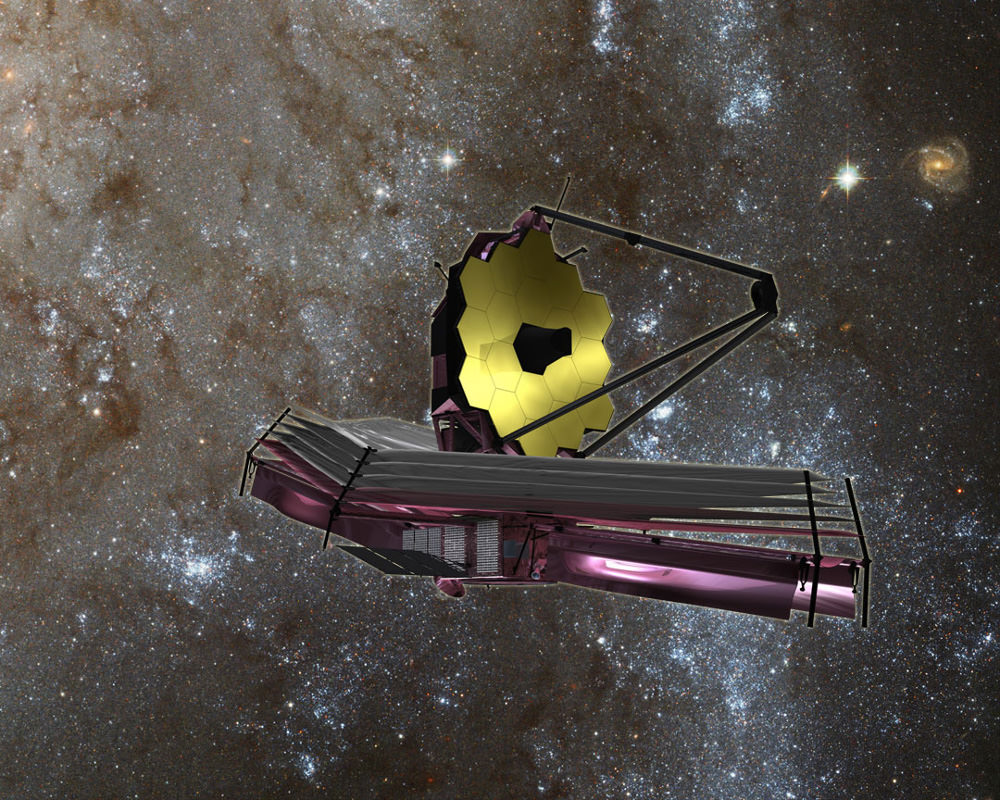
Northrop Grumman designed the Webb telescope’s optics and spacecraft bus for NASA’s Goddard Space Flight Center in Greenbelt, Maryland, which manages Webb.
Watch for Ken’s onsite space mission reports direct from the Kennedy Space Center and Cape Canaveral Air Force Station, Florida.
Stay tuned here for Ken’s continuing Earth and Planetary science and human spaceflight news.
………….
Learn more about the upcoming ULA Atlas NRO NROL-52 spysat launch on Oct 5 and SpaceX Falcon 9 SES-11 launch on Oct 7, JWST, OSIRIS-REx, NASA missions and more at Ken’s upcoming outreach events at Kennedy Space Center Quality Inn, Titusville, FL:
Oct 3-6, 8: “ULA Atlas NRO NROL-52 spysat launch, SpaceX SES-11, CRS-12 resupply launches to the ISS, Intelsat35e, BulgariaSat 1 and NRO Spysat, SLS, Orion, Commercial crew capsules from Boeing and SpaceX , Heroes and Legends at KSCVC, ULA Atlas/John Glenn Cygnus launch to ISS, SBIRS GEO 3 launch, GOES-R weather satellite launch, OSIRIS-Rex, Juno at Jupiter, InSight Mars lander, SpaceX and Orbital ATK cargo missions to the ISS, ULA Delta 4 Heavy spy satellite, Curiosity and Opportunity explore Mars, Pluto and more,” Kennedy Space Center Quality Inn, Titusville, FL, evenings
Northrop Grumman Acquires Orbital ATK for $9.2 Billion
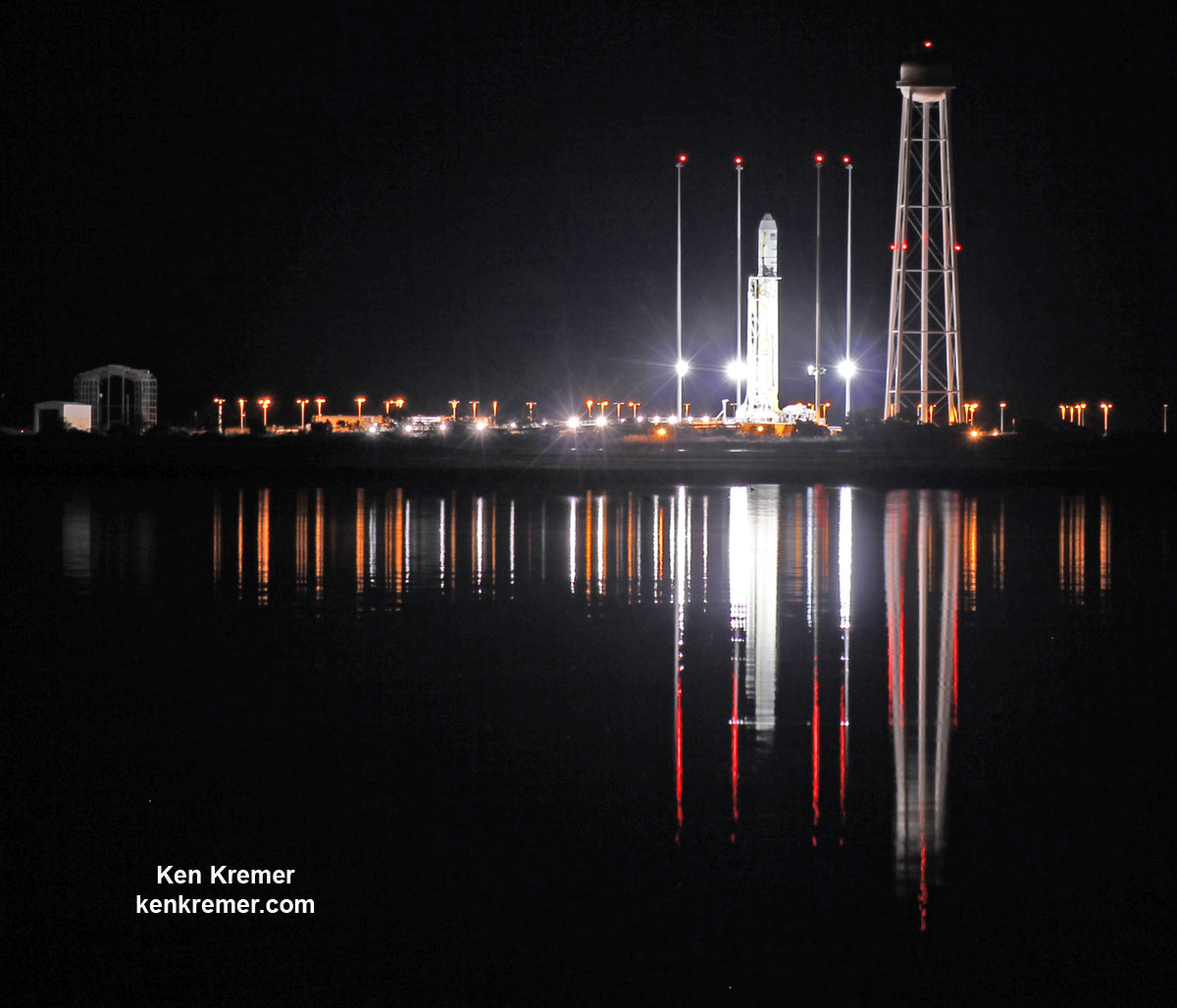

Aerospace giant Northrop Grumman will acquire Orbital ATK for approximately $9.2 billion, in a deal the companies announced Monday and they say will “expand capability” is largely “complementary” and involves “little overlap.”
Orbital ATK specializes in a wide variety of launch vehicles, satellites, missiles and munitions that Northrop believes will significantly enhance capabilities it lacks while offering Orbital significantly more technical and financial resources to grow sales and business opportunities.
Under the terms of the huge deal West Falls Church, Virginia based Northrop will dole out approximately $7.8 billion in cash to buy Dulles, Virginia based Orbital ATK and assume $1.4 billion in net debt. Orbital ATK shareholders will receive all-cash consideration of $134.50 per share, which is about a 20% premium above the stock’s price of $110 per share at the close of trading Friday, Sept. 15.
Rumors of the deal first appeared on Sunday.
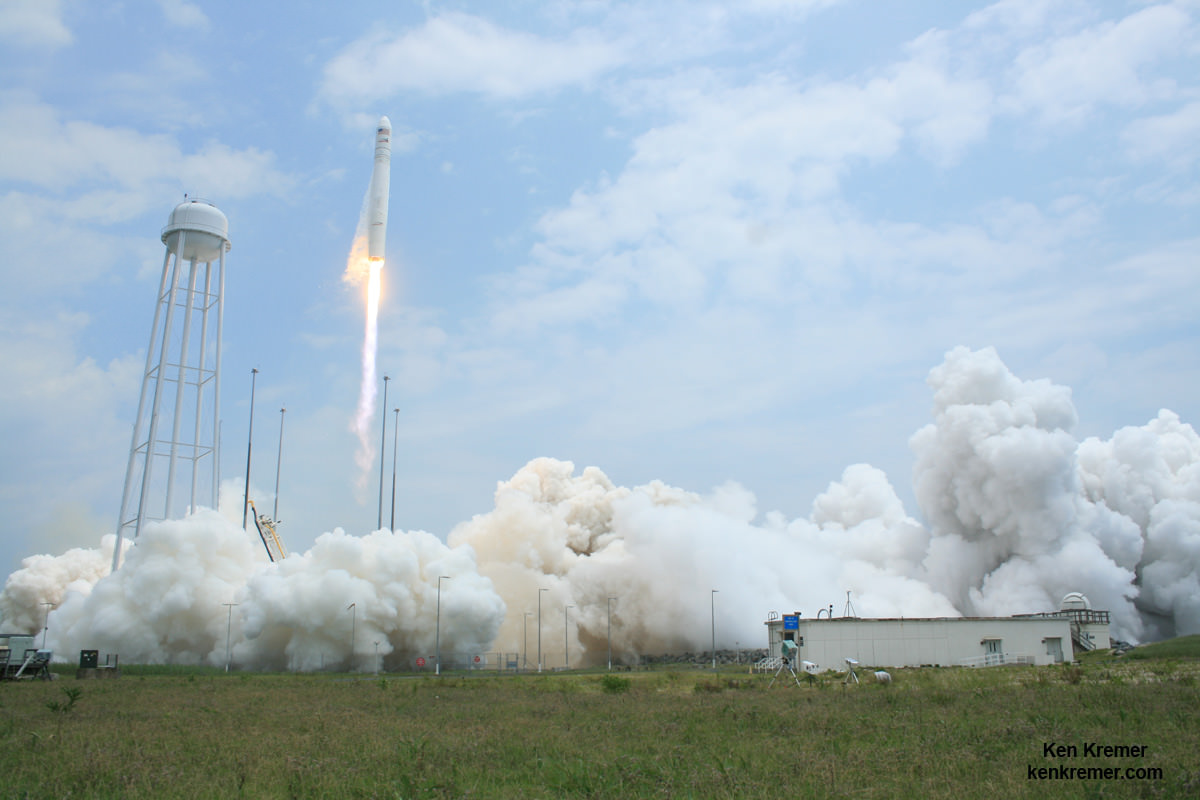
The final purchase is expected to take place around mid-2018, subject to approval by government regulators and Orbital ATK shareholders.
The Boards of Directors of both companies have already given unanimous approval to the mega buyout.
“Our two companies represent a very complementary fit,” Wes Bush, chief executive officer and president of Northrop Grumman said in a conference call on Monday, Sept. 18.
“We have very little overlap, and we fully expect our combined portfolios of leading technologies, along with our aligned and innovation-focused cultures, to yield significant value creation through revenue, cost and operational synergies, accelerating our profitable growth trajectory.”
Northrop indicated that Orbital ATK will operate as a separate fourth unit – at least initially – and that Orbital programs will benefit from the increased financial resources available from Northrup.
“Upon completion of the acquisition, Northrop Grumman plans to establish Orbital ATK as a new, fourth business sector to ensure a strong focus on operating performance and a smooth transition into Northrop Grumman.”
For his part Orbital ATK CEO David Thompson was very pleased with the buyout and future opportunities.
“The agreement reflects the tremendous value that Orbital ATK has created for our customers, our shareholders and our employees,” David Thompson, Orbital ATK president and chief executive officer said at the conference call.
“The combination will allow our team as a new business sector within Northrop Grumman to maintain strong operational performance on existing customer programs and to pursue new opportunities that require greater technical and financial resources than we currently possess.”
“Our collective customers should benefit from the expanded capabilities for innovation, increased speed of delivery and improved affordability of production resulting from the combination.”
“The combination of our companies and human capital will also significantly benefit our customers,” Bush elaborated. “Together, we can offer our customers enhanced mission capabilities and more competitive offerings in areas such as space, missiles and strategic deterrents.
“Our shareholders can expect revenue synergies from these new business opportunities.”
Northrop Grumman sales for 2017 amount to about $25 billion vs. about $4.5 billion for Orbital ATK
Orbital ATK itself is the product of a very recent merger in 2015 of Orbital Sciences and ATK.
The company employs over 13,000 people including over 4,200 scientists and engineers. It holds a heft backlog of contracts worth more than $15 billion.
Northrop Grumman employs over 68,000 people and is the fifth largest defense contractor.
“The agreement will also provide expanded career options for our employees as part of a larger, more diverse aerospace and defense company,” said Thompson.
It will also benefit stockholders.
“The transaction represents a truly compelling financial proposition for our shareholders, valuing the enterprise at about $9.2 billion and providing our investors with more than 120% total return over the 3-year period from the completion of the Orbital ATK merger in early 2015 to the expected closing in the first half of 2018.”
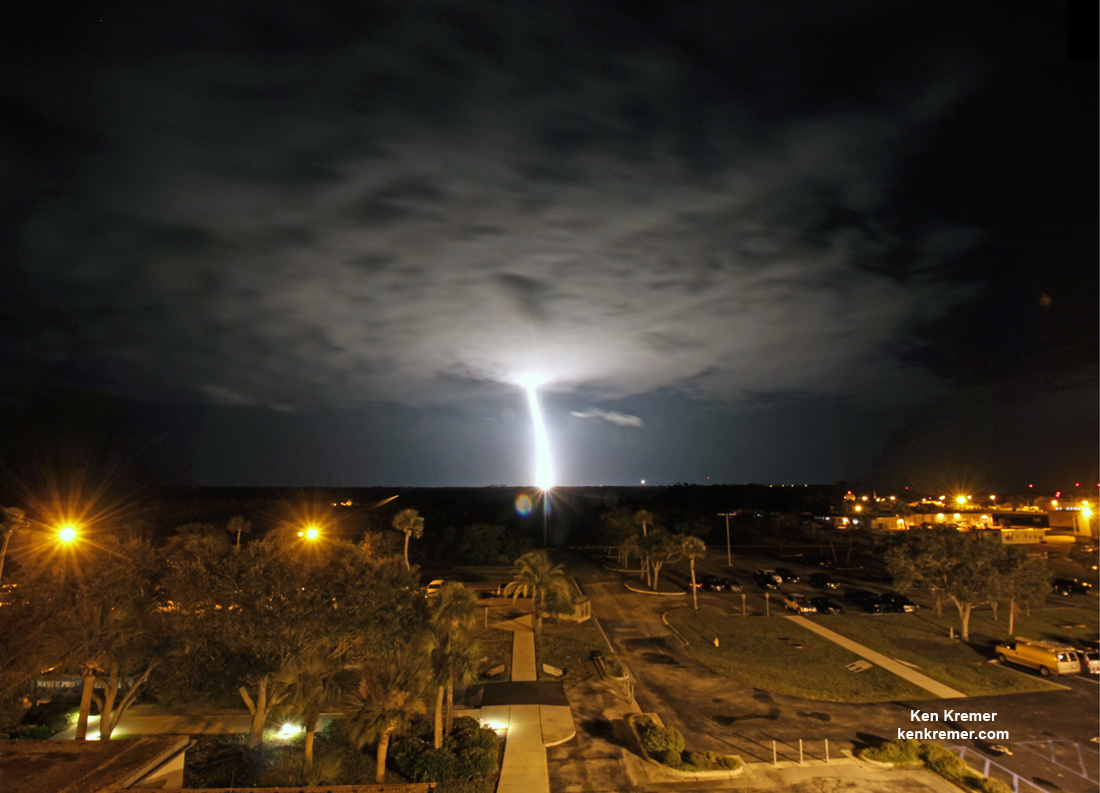
Orbital ATK launchers run the gamut from small to medium to large.
The rockets include the massive solid rocket boosters for NASA’s Space Launch System (SLS) heavy lift rocket under development, the Antares liquid fueled booster used to launch Cygnus cargo freighters to the International Space Station for NASA, the Minotaur family of medium class solid rocket launchers, as well as sounding rockets for a variety of low weight science missions.
The most recent Orbital ATK launch took place on Aug. 26 when a Minotaur 4 rocket (a retired Peacekeeper ICBM) lifted off from Cape Canaveral with a USAF surveillance satellite.
Orbital ATK also has a thriving satellite manufacturing business building NASA science, commercial, government and military satellites.
Northrop Grumman is the prime contractor for NASA’s James Webb Space Telescope and designed the optics and spacecraft bus under contract for NASA’s Goddard Space Flight Center in Greenbelt, Maryland.

The purchase is also estimated to result in $150 million in annual cost savings by 2020.
“We believe that this combination represents a compelling value creation opportunity for the customers, shareholders and employees of both our companies,” stated Bush. “Through our combination, all of our stakeholders will benefit from expanded capabilities, accelerated innovation and greater competitiveness in critical global security domains.”
Watch for Ken’s continuing onsite NASA mission and launch reports direct from the Kennedy Space Center, and Cape Canaveral Air Force Station, Florida, and NASA Wallops Flight Facility, Va.
Stay tuned here for Ken’s continuing Earth and Planetary science and human spaceflight news.

Weekly Space Hangout -Sept 13, 2017: Dr. Claudia Lagos from ICRAR
Hosts:
Fraser Cain (universetoday.com / @fcain)
Dr. Paul M. Sutter (pmsutter.com / @PaulMattSutter)
Dr. Kimberly Cartier ( KimberlyCartier.org / @AstroKimCartier )
Dr. Morgan Rehnberg (MorganRehnberg.com / @MorganRehnberg ChartYourWorld.org)
Special Guest:
This week’s guest is Dr. Claudia Lagos (@CDPLagos).
Claudia is the Research Assistant at the International Centre for Radio Astronomy Research, in the University of Western Australia. Dr. Lagos is one of the core researchers for the Cosmic Dawn Centre (DAWN). Her expertise is in modelling of physical processes in galaxies, such as gas accretion onto galaxies, star formation, stellar feedback, gas accretion onto black holes, among other similar mechanisms.
Their stories this week:
We use a tool called Trello to submit and vote on stories we would like to see covered each week, and then Fraser will be selecting the stories from there. Here is the link to the Trello WSH page (http://bit.ly/WSHVote), which you can see without logging in. If you’d like to vote, just create a login and help us decide what to cover!
Announcements:
If you would like to join the Weekly Space Hangout Crew, visit their site here and sign up. They’re a great team who can help you join our online discussions!
We record the Weekly Space Hangout every Wednesday at 5:00 pm Pacific / 8:00 pm Eastern. You can watch us live on Universe Today, or the Weekly Space Hangout YouTube page
Sunshield Layers Installed on NASA’s James Webb Space Telescope as Mirror Cryo Cooling Testing Commences


The complex multilayered sunshield that will protect the delicate optics and state of the art infrared science instruments of NASA’s James Webb Space Telescope (JWST) is now fully installed on the spacecraft bus in California, completing another major milestone on the path to launch, NASA announced.
Meanwhile a critical cryogenic cooling test of Webb’s mirrors and science instrument bus has commenced inside a giant chamber at NASA’s Johnson Space Center in Texas, marking another major milestone as the mammoth telescope comes together after years of development.
NASA’s $8.8 Billion James Webb Space Telescope is the most powerful space telescope ever built and is the scientific successor to the phenomenally successful Hubble Space Telescope (HST).
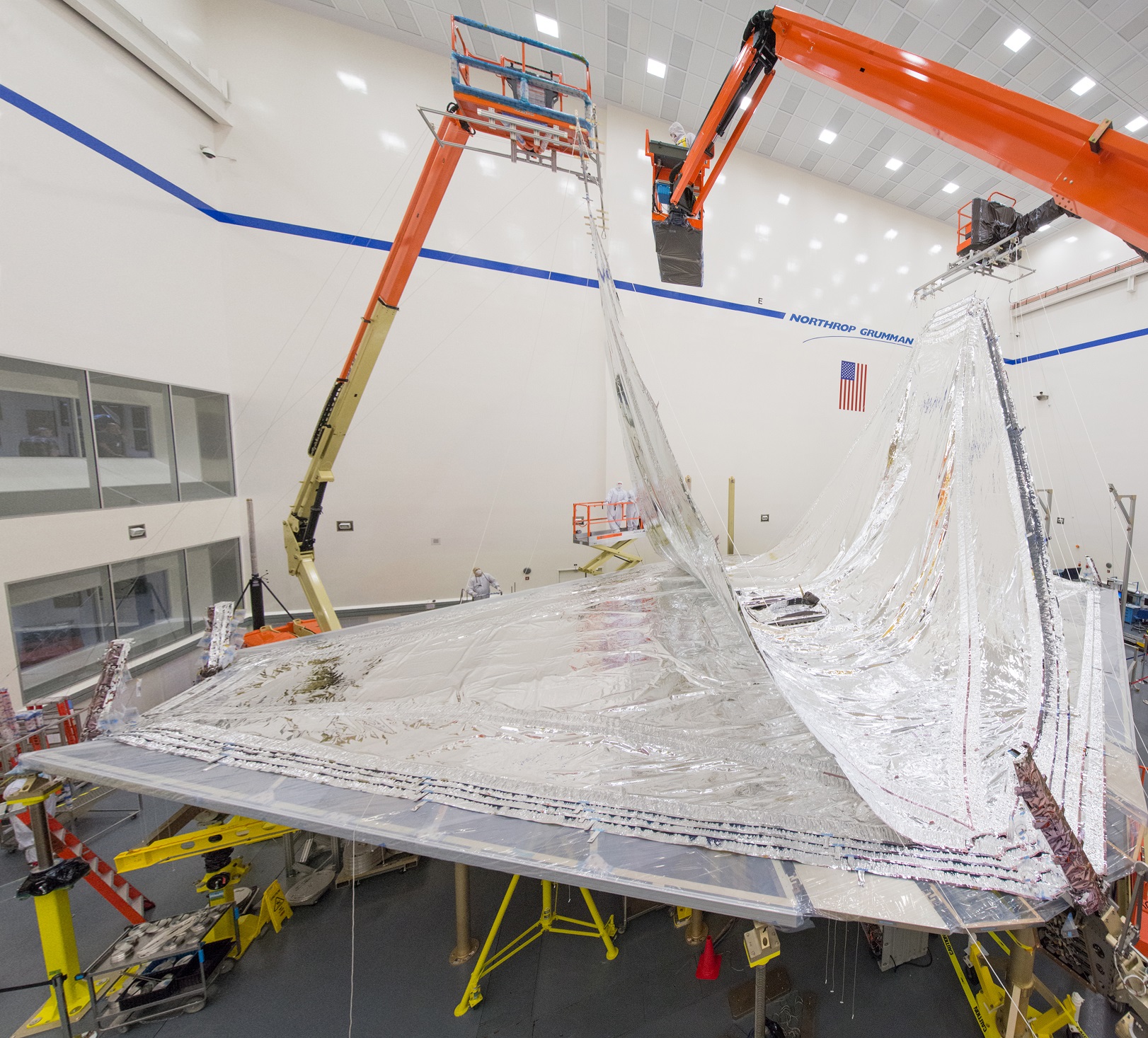
Credits: Northrop Grumman Corp.
The Webb telescopes groundbreaking tennis court sized sunshield subsystem consists of five layers of kapton that will keep the optics and instruments incredibly cool, by reducing the incoming sunside facing temperature more than 570 degrees Fahrenheit. Each layer is as thin as a human hair.
“The sunshield layers work together to reduce the temperatures between the hot and cold sides of the observatory by approximately 570 degrees Fahrenheit,” according to NASA. “Each successive layer of the sunshield is cooler than the one below.”
The painstaking work to integrate the five sunshield membranes was carried out in June and July by engineers and technicians working at the Northrop Grumman Corporation facility in Redondo Beach, California.
“All five sunshield membranes have been installed and will be folded over the next few weeks,” said Paul Geithner, deputy project manager – technical for the Webb telescope at NASA’s Goddard Space Flight Center in Greenbelt, Maryland, in a statement.
Deployment tests of the folded sunshield start in August.
Webb’s four research instruments cannot function without the essential cooling provided by the sunshield deployment.
Northrop Grumman designed the Webb telescope’s optics and spacecraft bus for NASA’s Goddard Space Flight Center in Greenbelt, Maryland, which manages Webb.

“This is a huge milestone for the Webb telescope as we prepare for launch,” said Jim Flynn, Webb sunshield manager, Northrop Grumman Aerospace Systems.
“The groundbreaking tennis court sized sunshield will shield the optics from heat and assist in providing the imaging of the formation of stars and galaxies more than 13.5 billion years ago.”

Webb is designed to look at the first light of the Universe and will be able to peer back in time to when the first stars and first galaxies were forming. It will also study the history of our universe and the formation of our solar system as well as other solar systems and exoplanets, some of which may be capable of supporting life on planets similar to Earth.
After successfully passing a rigorous series of vibration and acoustic environmental tests earlier this year at NASA Goddard in March, the mirror and instrument assembly was shipped to NASA Johnson in May for the cryo cooling tests.
“Those tests ensured Webb can withstand the vibration and noise created during the telescope’s launch into space. Currently, engineers are analyzing this data to prepare for a final round of vibration and acoustic testing, once Webb is joined with the spacecraft bus and sunshield next year,” says NASA.
The cryogenic cooling test will last 100 days and is being carried out inside the giant thermal vacuum known as Chamber A at the Johnson Space Center in Houston.

“A combination of liquid nitrogen and cold gaseous helium will be used to cool the telescope and science instruments to their operational temperature during high-vacuum operations,” said Mark Voyton, manager of testing effort, who works at the NASA Goddard Space Flight Center in Greenbelt, Maryland.
Next year, the tennis-court sized sunshield and spacecraft bus will be combined to make up the entire observatory.
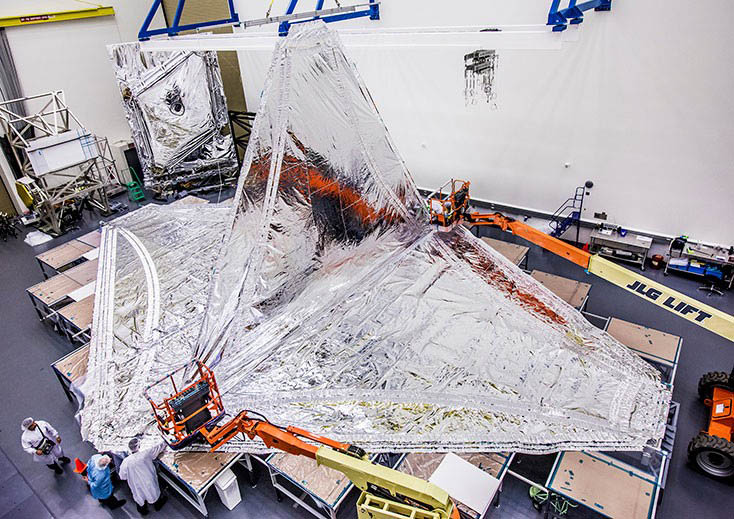
The Webb Telescope is a joint international collaborative project between NASA, the European Space Agency (ESA) and the Canadian Space Agency (CSA).
Assembly of the Webb telescope is currently on target and slated to launch on an ESA Ariane V booster from the Guiana Space Center in Kourou, French Guiana in October 2018.
NASA and ESA are currently evaluating a potential launch scheduling conflict with ESA’s BepiColombo mission to Mercury.

Watch for Ken’s onsite space mission reports direct from the Kennedy Space Center and Cape Canaveral Air Force Station, Florida.
Stay tuned here for Ken’s continuing Earth and Planetary science and human spaceflight news.

………….
Learn more about the upcoming SpaceX Dragon CRS-12 resupply launch to ISS on Aug. 14, ULA Atlas TDRS-M NASA comsat on Aug. 18, 2017 Solar Eclipse, NASA missions and more at Ken’s upcoming outreach events at Kennedy Space Center Quality Inn, Titusville, FL:
Aug 11-14: “SpaceX CRS-12 and CRS-11 resupply launches to the ISS, Inmarsat 5, BulgariaSat 1 and NRO Spysat, EchoStar 23, SLS, Orion, Commercial crew capsules from Boeing and SpaceX , Heroes and Legends at KSCVC, ULA Atlas/John Glenn Cygnus launch to ISS, SBIRS GEO 3 launch, GOES-R weather satellite launch, OSIRIS-Rex, Juno at Jupiter, InSight Mars lander, SpaceX and Orbital ATK cargo missions to the ISS, ULA Delta 4 Heavy spy satellite, Curiosity and Opportunity explore Mars, Pluto and more,” Kennedy Space Center Quality Inn, Titusville, FL, evenings
Astronomy Cast Ep. 454: Things We’re Looking Forward To
As we wrap up season 10 of Astronomy Cast, we look forward to all the instruments, missions and science results on the distant horizon. Think astronomy is exciting already? Just you wait.
We’re taking our summer hiatus during July and August, but we’ll be back in September with all-new episodes!
Visit the Astronomy Cast Page to subscribe to the audio podcast!
We usually record Astronomy Cast as a live Google+ Hangout on Air every Friday at 1:30 pm Pacific / 4:30 pm Eastern. You can watch here on Universe Today or from the Astronomy Cast Google+ page.
Trump Proposes $19.1 Billion 2018 NASA Budget, Cuts Earth Science and Education
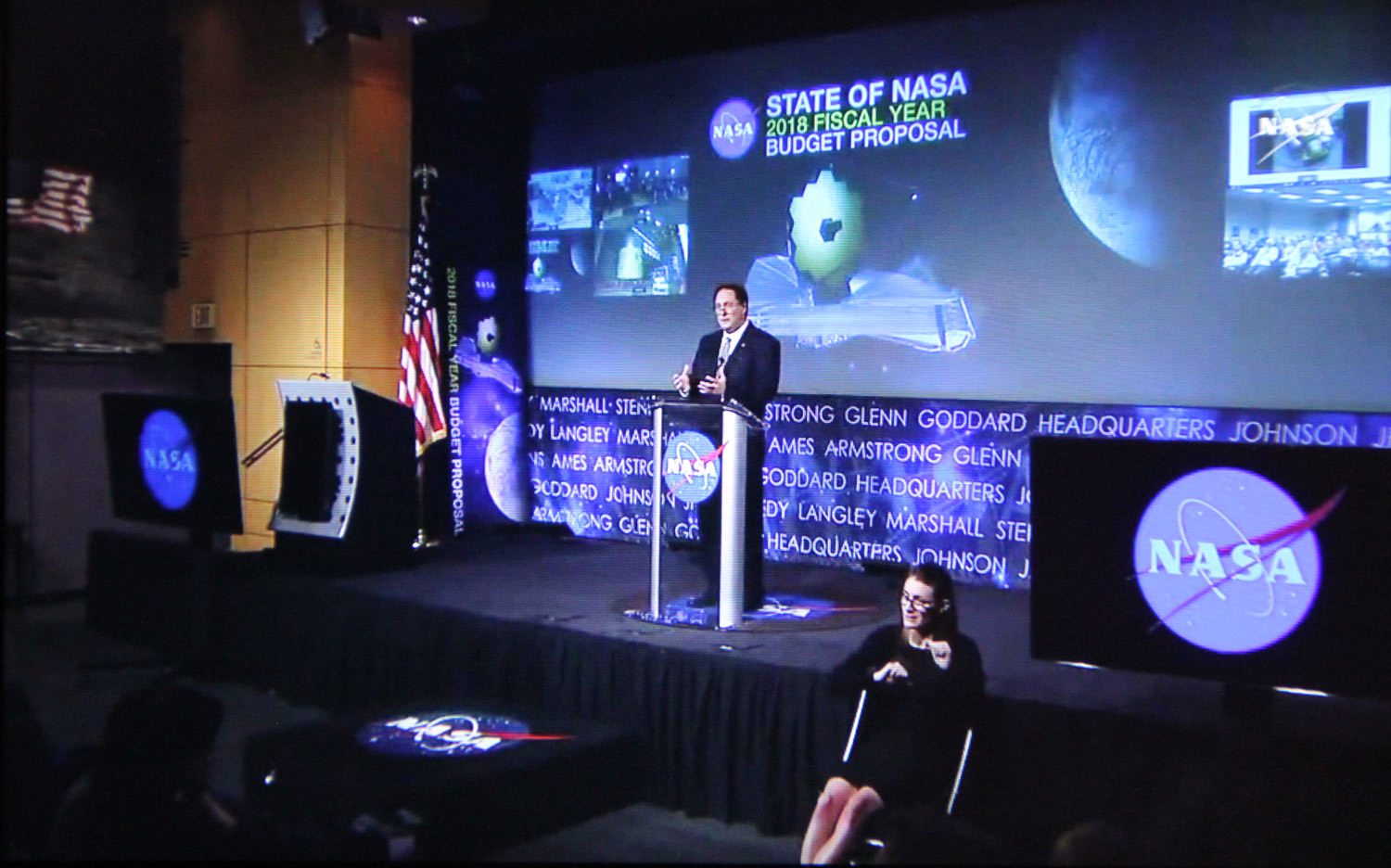

The Trump Administration has proposed a $19.1 Billion NASA budget request for Fiscal Year 2018, which amounts to a $0.5 Billion reduction compared to the recently enacted FY 2017 NASA Budget. Although it maintains many programs such as human spaceflight, planetary science and the Webb telescope, the budget also specifies significant cuts and terminations to NASA’s Earth Science and manned Asteroid redirect mission as well as the complete elimination of the Education Office.
Overall NASA’s FY 2018 budget is cut approximately 3%, or $560 million, for the upcoming fiscal year starting in October 2017 as part of the Trump Administration’s US Federal Budget proposal rolled out on May 23, and quite similar to the initial outline released in March.
The cuts to NASA are smaller compared to other Federal science agencies also absolutely vital to the health of US scientific research – such as the NIH, the NSF, the EPA, DOE and NIST which suffer unconscionable double digit slashes of 10 to 20% or more.
The highlights of NASA’s FY 2018 Budget were announced by NASA acting administrator Robert Lightfoot during a ‘State of NASA’ speech to agency employees held at NASA HQ, Washington, D.C. and broadcast to the public live on NASA TV.
Lightfoot’s message to NASA and space enthusiasts was upbeat overall.
“What this budget tells us to do is to keep going!” NASA acting administrator Robert Lightfoot said.
“Keep doing what we’ve been doing. It’s very important for us to maintain that course and move forward as an agency with all the great things we’re doing.”
“I want to reiterate how proud I am of all of you for your hard work – which is making a real difference around the world. NASA is leading the world in space exploration, and that is only possible through all of your efforts, every day.”
“We’re pleased by our top line number of $19.1 billion, which reflects the President’s confidence in our direction and the importance of everything we’ve been achieving.”
Lightfoot recalled the recent White House phone call from President Trump to NASA astronaut & ISS Station Commander Peggy Whitson marking her record breaking flight for the longest cumulative time in space by an American astronaut.
Thus Lightfoot’s vision for NASA has three great purposes – Discover, Explore, and Develop.
“NASA has a historic and enduring purpose. It can be summarized in three major strategic thrusts: Discover, Explore, and Develop. These correspond to our missions of scientific discovery, missions of exploration, and missions of new technology development in aeronautics and space systems.”
Lightfoot further recounted the outstanding scientific accomplishments of NASA’s Mars rover and orbiters paving the path for the agencies plans to send humans on a ‘Journey to Mars’ in the 2030s.
“We’ve had a horizon goal for some time now of reaching Mars, and this budget sustains that work and also provides the resources to keep exploring our solar system and look beyond it.”
Lightfoot also pointed to upcoming near term science missions- highlighting a pair of Mars landers – InSIGHT launching next year as well as the Mars 2020 rover. Also NASA’s next great astronomical observatory – the James Webb Space Telescope (JWST).
“In science, this budget supports approximately 100 missions: 40 missions currently preparing for launch & 60 operating missions.”
“The James Webb Space Telescope is built!” Lightfoot gleefully announced.
“It’s done testing at Goddard and now has moved to Johnson for tests to simulate the vacuum of space.”
JWST is the scientific successor to the Hubble Space Telescope and slated for launch in Oct. 2018. The budget maintains steady support for Webb.

The Planetary Sciences division receives excellent support with a $1.9 Billion budget request. It includes solid support for the two flagship missions – Mars 2020 and Europa Clipper as well as the two new Discovery class missions selected -Lucy and Psyche.
“The budget keeps us on track for the next selection for the New Frontiers program, and includes formulation of a mission to Jupiter’s moon Europa.”
“SLS and Orion are making great progress. They are far beyond concepts, and as I mentioned, components are being tested in multiple ways right now as we move toward the first flight of that integrated system.”
NASA is currently targeting the first integrated launch of SLS and Orion on the uncrewed Exploration Mission-1 (EM-1) for sometime in 2019.
Top NASA managers recently decided against adding a crew of two astronauts to the flight after conducting detailed agency wide studies at the request of the Trump Administration.
NASA would have needed an additional $600 to $900 to upgrade EM-1 with humans.
Unfortunately Trump’s FY 2018 NASA budget calls for a slight reduction in development funding for both SLS and Orion – thus making a crewed EM-1 flight fiscally unviable.
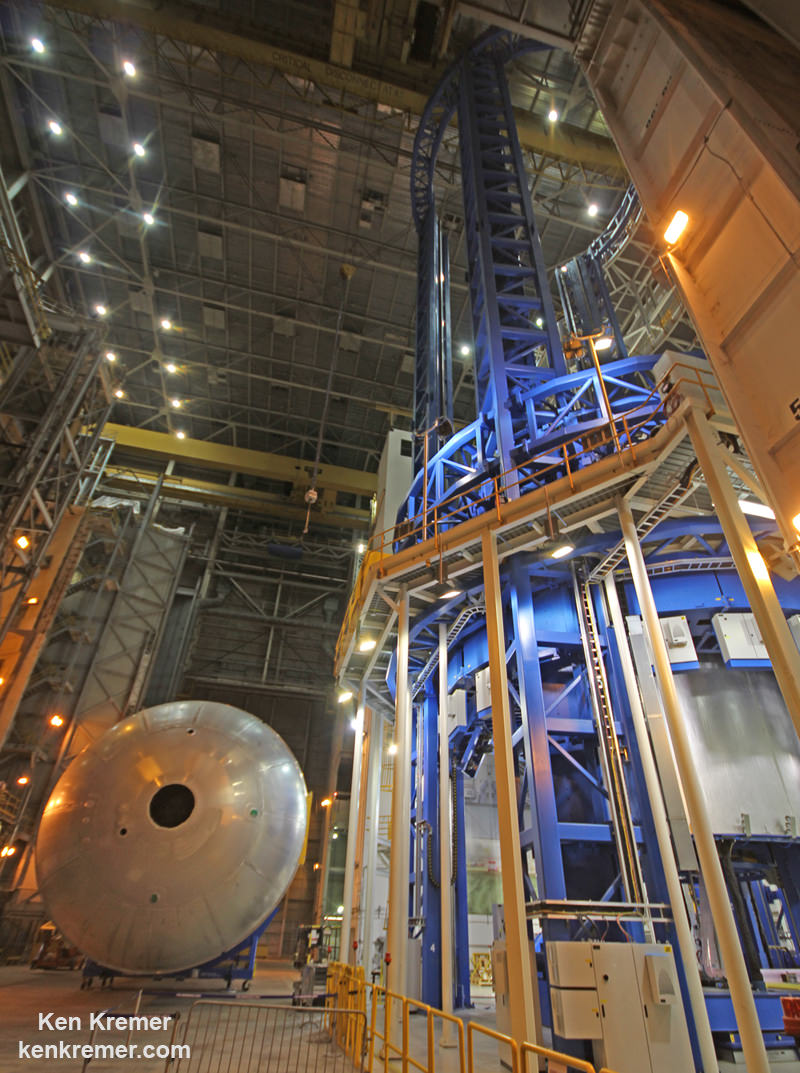
The budget request does maintain full funding for both of NASA’s commercial crew vehicles planned to restore launching astronauts to low Earth orbit (LEO) and the ISS from US soil on US rockets – namely the crewed Dragon and CST-100 Starliner – currently under development by SpaceX and Boeing – thus ending our sole reliance on Russian Soyuz for manned launches.
“Working with commercial partners, NASA will fly astronauts from American soil on the first new crew transportation systems in a generation in the next couple of years.”
“We need commercial partners to succeed in low-Earth orbit, and we also need the SLS and Orion to take us deeper into space than ever before.”
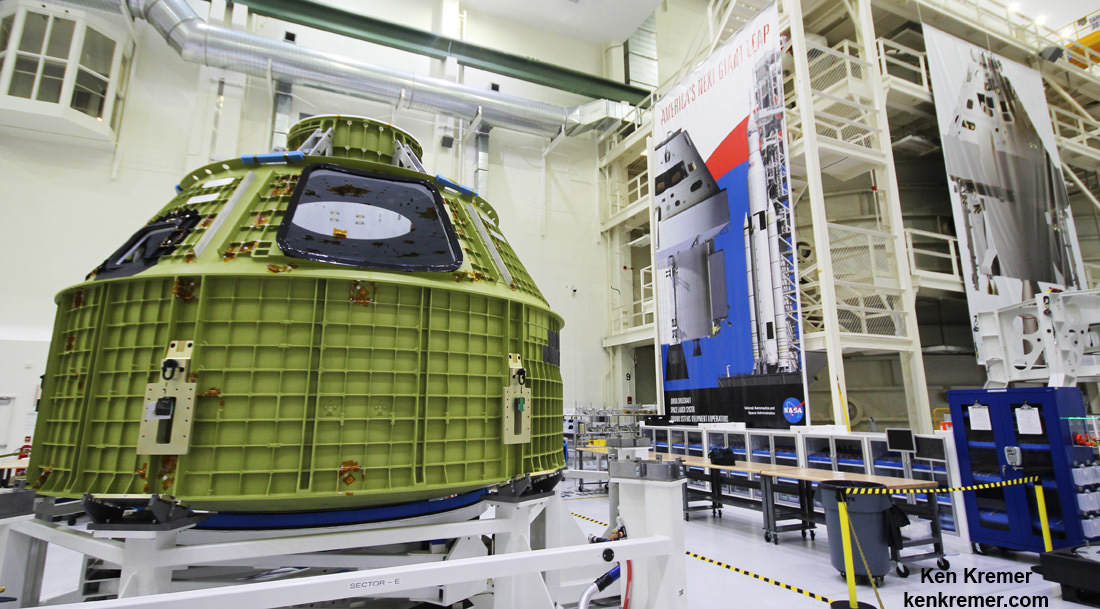
However the Trump Administration has terminated NASA’s somewhat controversial plans for the Asteroid Redirect Mission (ARM) – initiated under the Obama Administration – to robotically retrieve a near Earth asteroid and redirect it to lunar orbit for a visit by a crewed Orion to gather unique asteroidal samples.
“While we are ending formulation of a mission to an asteroid, known as the Asteroid Redirect Mission, many of the central technologies in development for that mission will continue, as they constitute vital capabilities needed for future human deep space missions.”
Key among those vital capabilities to be retained and funded going forward is Solar Electric Propulsion (SEP).
“Solar electric propulsion (SEP) for our deep space missions is moving ahead as a key lynchpin.”
The Trump Administration’s well known dislike for Earth science and disdain of climate change has manifested itself in the form of the termination of 5 current and upcoming science missions.
NASA’s FY 2018 Earth Science budget suffers a $171 million cut to $1.8 Billion.
“While we are not proposing to move forward with Orbiting Carbon Observatory-3 (OCO-3), Plankton, Aerosol, Cloud, ocean Ecosystem (PACE), Climate Absolute Radiance and Refractivity Observatory Pathfinder (CLARREO PF), and the Radiation Budget Instrument (RBI), this budget still includes significant Earth Science efforts, including 18 Earth observing missions in space as well as airborne missions.”
The DSCOVR Earth-viewing instruments will also be shut down.
NASA’s Office of Education will also be terminated completely under the proposed FY 2018 budget and the $115 million of funding excised.
“While this budget no longer supports the formal Office of Education, NASA will continue to inspire the next generation through its missions and the many ways that our work excites and encourages discovery by learners and educators. Let me tell you, we are as committed to inspiring the next generation as ever.”
Congress will now have its say and a number of Senators, including Republicans says Trumps budget is DOA.
Stay tuned here for Ken’s continuing Earth and Planetary science and human spaceflight news.

